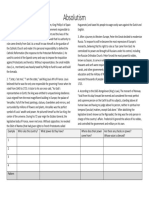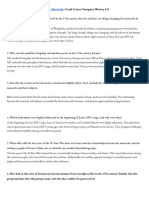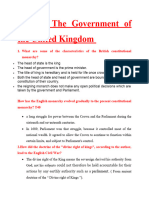0 ratings0% found this document useful (0 votes)
10 viewsAgeofAbsolutismPowerpoint 1
AgeofAbsolutismPowerpoint 1
Uploaded by
vferrara2Copyright:
© All Rights Reserved
Available Formats
Download as PPT, PDF, TXT or read online from Scribd
AgeofAbsolutismPowerpoint 1
AgeofAbsolutismPowerpoint 1
Uploaded by
vferrara20 ratings0% found this document useful (0 votes)
10 views28 pagesOriginal Title
AgeofAbsolutismPowerpoint-1
Copyright
© © All Rights Reserved
Available Formats
PPT, PDF, TXT or read online from Scribd
Share this document
Did you find this document useful?
Is this content inappropriate?
Copyright:
© All Rights Reserved
Available Formats
Download as PPT, PDF, TXT or read online from Scribd
Download as ppt, pdf, or txt
0 ratings0% found this document useful (0 votes)
10 views28 pagesAgeofAbsolutismPowerpoint 1
AgeofAbsolutismPowerpoint 1
Uploaded by
vferrara2Copyright:
© All Rights Reserved
Available Formats
Download as PPT, PDF, TXT or read online from Scribd
Download as ppt, pdf, or txt
You are on page 1of 28
Overview-Absolutism
In the 1500s and 1600s,
several rulers in Asia and
Europe looked to centralize
their political power.
Claiming divine right, or
authority from God, leaders
such as Louis XIV in France
gained complete authority
over their governments and
their subjects.
England resisted the establishment of absolutism.
After a civil war, England’s Parliament enacted a Bill
of Rights that limited the English monarch’s powers.
Overview
Main Ideas:
• Monarchs acted to
establish absolute power
• Monarchs used the divine
right theory and similar
ideas to justify their power
• Parliament and the
Puritans in England
resisted absolutism
• A limited monarchy was
established in England
Absolutism
Absolutism: Belief that
monarchs hold supreme
power, and are responsible
only to has
• King God.all power=central
• People have no power
•complete authority over their
governments
Divine Right Theory: Idea
that a king gets his authority
to rule directly from God.
ABSOLUTISM IN FRANCE
By the late 1600s, France had
replaced Spain as the most
powerful European nation.
Louis XIV
Country: France
Years: 1643 – 1715 (72 years!)
Achievements:
-Called himself the “Sun King”
and said “I am the state.”
-Strengthened the monarchy,
expanded bureaucracy, built
palace of Versailles, strongest
army in Europe, made France a
wealthy cultural center.
Downfalls: Used the wealth for
his own benefit, peasants
starved, numerous wars, never
called Estates General. The
French monarchy would not
survive long after Louis’ death.
ABSOLUTISM IN RUSSIA
The driving force behind Russia’s
rise to power was Ivan III (Ivan
the Great). He built the
framework for absolute rule in
Russia, which would only get
worse.
Ivan the Terrible
Country: Russia
Years: 1533 - 1584
Achievements: Introduced
extreme absolute power,
expanded Russian lands,
made Russia more religious.
Downfalls: Set up the first
Russian secret police, who
murdered thousands for
him. He killed many nobles
and destroyed many towns,
and even killed his own son
in a fit of rage.
Peter the Great
Country: Russia
Years: 1682 - 1725
Achievements:
-Westernization: brought
European influence to
Russia, St. Petersburg,
modern army, new
industries, education, warm
water port (Baltic Sea),
extended borders, unified
the nation, reduced power
of nobility, gained control of
Russian
Downfalls:Orthodox Church.
Did not reach
Black sea, reforms died
with him.
COUNTRY: India
YEAR: 1556-1605
Achievements:
become ruler at the age of 14.
Skilled military commander
Built the largest army ever in the
empire.
Helped to conquer northern India
and Pakistan.
Great administrator
developed a centralized government
(bureaucracy)
Best known for tolerance of his
subjects (especially Hindus)
Downfalls: Akbar's successors were
not as strong. Mughal power
declined
Summary
Through the 1500s and 1600s absolutism became
dominant through much of Europe and parts of Asia.
In Spain, France, and Russia, absolutist monarchs
claimed that they ruled by divine right and sought to
extend their political power. While other nations
accepted absolutism, England stood as a contrast to
this trend. After the Puritan Revolution and the
Glorious Revolution of the mid-1600s, the English Bill
of Rights was passed establishing England as a
limited monarchy.
You might also like
- 262 - Asmodeus The Lord of LustDocument385 pages262 - Asmodeus The Lord of LustAdriana94% (18)
- USA The Republic Is The House That NO ONE Lives inDocument103 pagesUSA The Republic Is The House That NO ONE Lives inPedro Rambito100% (1)
- AP Euro Boot Camp 1 - 24 P6Document27 pagesAP Euro Boot Camp 1 - 24 P6cannon butler100% (10)
- The Monarchs of EuropeDocument39 pagesThe Monarchs of Europeapi-271959377No ratings yet
- Absolutism Intro ComboDocument4 pagesAbsolutism Intro Comboapi-262588001100% (1)
- The Rise of Absolutism, NotesDocument5 pagesThe Rise of Absolutism, NotesSiesmicNo ratings yet
- Prophet S Agenda The Divine Plan of The AgesDocument3 pagesProphet S Agenda The Divine Plan of The Agesbroadband_dryfter100% (1)
- AbsolutelyDocument2 pagesAbsolutelyElsa Pajayat AlipinNo ratings yet
- H&ss #4 #7 - Absolitism and Nation-State ConstitutionDocument6 pagesH&ss #4 #7 - Absolitism and Nation-State ConstitutionGaloNo ratings yet
- The Age Of: Absolute MonarchsDocument48 pagesThe Age Of: Absolute MonarchsIshaan KhandelwalNo ratings yet
- Absolutism: Seventeenth CenturyDocument16 pagesAbsolutism: Seventeenth CenturyHugo FloresNo ratings yet
- Assignment On Absolute MonarchyDocument7 pagesAssignment On Absolute Monarchysitamukhia15No ratings yet
- 3 Absolute MonarchsDocument38 pages3 Absolute MonarchsEl KachtoulNo ratings yet
- CHAPTER 14 - Crisis and Absolutism in EuropeDocument25 pagesCHAPTER 14 - Crisis and Absolutism in EuropeJonathan Daniel KeckNo ratings yet
- Age of AbsolutismVG PPT - ADocument86 pagesAge of AbsolutismVG PPT - ALucky HamachinoNo ratings yet
- Chapter 17 - The Emergence of The European State SystemDocument29 pagesChapter 17 - The Emergence of The European State SystemJonathan Daniel Keck50% (2)
- Summaries 1Document4 pagesSummaries 1viktoriastoilova6No ratings yet
- Decline of Feudalism - Rise of Nation StatesDocument34 pagesDecline of Feudalism - Rise of Nation StatesMihai GogoşanuNo ratings yet
- 3.1-2A EuropeDocument32 pages3.1-2A Europegarrettyang91No ratings yet
- Ch. 13 Outline ActivityDocument3 pagesCh. 13 Outline Activityjqncc5cwz8No ratings yet
- Absolute Monarchs in EuropeDocument34 pagesAbsolute Monarchs in EuropeAzimul Aktar BarbhuiyaNo ratings yet
- file-551106650Document6 pagesfile-551106650StanleyNo ratings yet
- Global History Cours 3Document6 pagesGlobal History Cours 3Gasselin LeaNo ratings yet
- Absolutism or Age of AbsolutismDocument14 pagesAbsolutism or Age of AbsolutismRyan GayagoyNo ratings yet
- The Medieval University:: Scholasticism & Urban Intellectual LifeDocument61 pagesThe Medieval University:: Scholasticism & Urban Intellectual LifeyangliNo ratings yet
- Setting The Stage For RevolutionDocument26 pagesSetting The Stage For Revolutionvmonacelli8100No ratings yet
- Evolition of Modern Nation StatesDocument8 pagesEvolition of Modern Nation StatesSanjana k 26No ratings yet
- Absolute MonarchsDocument30 pagesAbsolute MonarchsBobNo ratings yet
- Mini Lesson One-Absolute Monarch IntroDocument2 pagesMini Lesson One-Absolute Monarch Introc. reyesNo ratings yet
- Age of Absolutism Vocabulary, Polyana AdamsDocument5 pagesAge of Absolutism Vocabulary, Polyana Adamspolyana.adams.robustoNo ratings yet
- 1 Divine Right AbsolutismDocument1 page1 Divine Right AbsolutismTherese85967% (3)
- Development of States in EuropeDocument2 pagesDevelopment of States in EuropeRommel Roy RomanillosNo ratings yet
- Absolutism and RevolutionDocument49 pagesAbsolutism and RevolutionZian BertilloNo ratings yet
- The Origin of State: The Evolutionary TheoryDocument3 pagesThe Origin of State: The Evolutionary TheoryMd. Mashfiq Rizvee 1811173642No ratings yet
- Unit 1 The Old RegimeDocument7 pagesUnit 1 The Old RegimeCANDELA VICENTE FERRERNo ratings yet
- Absolute Monarchy - Thomas HobbesDocument2 pagesAbsolute Monarchy - Thomas HobbesVanshika GaurNo ratings yet
- AbsolutismDocument2 pagesAbsolutismapi-327452561No ratings yet
- annotated-Philosopher%20Readings%202021Document8 pagesannotated-Philosopher%20Readings%202021723462No ratings yet
- Culture MonarchyDocument29 pagesCulture MonarchyJohn MalgapoNo ratings yet
- Recu GHDocument16 pagesRecu GHainhoa navarroNo ratings yet
- Absolutism: Sovereignty Monarch Dictator Agency Louis XIV Adolf Hitler Soviet Union Joseph StalinDocument1 pageAbsolutism: Sovereignty Monarch Dictator Agency Louis XIV Adolf Hitler Soviet Union Joseph StalinArshdeep KaurNo ratings yet
- French Revolution and Napolean NotesDocument12 pagesFrench Revolution and Napolean NotesJiya MakwanaNo ratings yet
- Absolutism Review SheetDocument6 pagesAbsolutism Review SheetPB and JalapenosNo ratings yet
- Absolute Monarchs in EuropeGF2024Document27 pagesAbsolute Monarchs in EuropeGF2024Ian Lay LizarribarNo ratings yet
- 1. French Revolution (1789–1799)Document7 pages1. French Revolution (1789–1799)cerenncinbasNo ratings yet
- 1. French Revolution (1789–1799)Document7 pages1. French Revolution (1789–1799)cerenncinbasNo ratings yet
- CCEH #13 Absolute MonarchyDocument3 pagesCCEH #13 Absolute Monarchyalvinvarghese8aNo ratings yet
- History Unit 10 - 11Document28 pagesHistory Unit 10 - 11AnasAbdelaNo ratings yet
- Topic 4 Statemaking - Absolutism and ConstitutionalismDocument72 pagesTopic 4 Statemaking - Absolutism and Constitutionalismsuelinanchong2No ratings yet
- Absolutism ConstitutionalismDocument5 pagesAbsolutism Constitutionalismapi-282463341No ratings yet
- The Enlightenment and The American RevolutionDocument8 pagesThe Enlightenment and The American RevolutionBevynNo ratings yet
- History Study Guide TermsDocument5 pagesHistory Study Guide TermsdoriadNo ratings yet
- Absolute Monarchy: Absolute Monarchy Is A Monarchical Form of Government in Which TheDocument4 pagesAbsolute Monarchy: Absolute Monarchy Is A Monarchical Form of Government in Which TheItsshk Shashi ShekharNo ratings yet
- Age of AbsolutismDocument6 pagesAge of Absolutismlyzlie CañedoNo ratings yet
- AP Euro CH 18Document16 pagesAP Euro CH 18Ashkan TorkamanNo ratings yet
- BIOGRAPHIESDocument3 pagesBIOGRAPHIESEsther San Pedro PellónNo ratings yet
- The Modern EraDocument2 pagesThe Modern EramarialopezcabreraNo ratings yet
- Weekly Reading 417-421pgDocument2 pagesWeekly Reading 417-421pgalexanderanyah550No ratings yet
- Absolutism Set ReadingsDocument10 pagesAbsolutism Set ReadingsMiguel SalvatNo ratings yet
- The Decline of Feudalism and Origin of The Early Modern StateDocument3 pagesThe Decline of Feudalism and Origin of The Early Modern StateRaphael AsiegbuNo ratings yet
- 0 - From Enlightment To RomanticismDocument11 pages0 - From Enlightment To RomanticismSarha FiorenzaNo ratings yet
- Gale Researcher Guide for: Literary, Spiritual, and Political Crosscurrents of the Seventeenth CenturyFrom EverandGale Researcher Guide for: Literary, Spiritual, and Political Crosscurrents of the Seventeenth CenturyNo ratings yet
- Royalty, Religion, Revolutions | Children's European HistoryFrom EverandRoyalty, Religion, Revolutions | Children's European HistoryNo ratings yet
- Day 38-Ancient Greece StationsDocument24 pagesDay 38-Ancient Greece Stationsvferrara2No ratings yet
- EnduringIssueEssayOutline-1Document5 pagesEnduringIssueEssayOutline-1vferrara2No ratings yet
- EnduringIssues-1Document14 pagesEnduringIssues-1vferrara2No ratings yet
- Copy of IndusDocument13 pagesCopy of Indusvferrara2No ratings yet
- AnimismGuidedReading-1Document2 pagesAnimismGuidedReading-1vferrara2No ratings yet
- 10.3 Industrial RevolutionDocument29 pages10.3 Industrial Revolutionvferrara2No ratings yet
- Age of Metternich: Europe From The Congress of Vienna Through The Unification of Italy & GermanyDocument5 pagesAge of Metternich: Europe From The Congress of Vienna Through The Unification of Italy & Germanyvferrara2No ratings yet
- The Patriarchal Theory-The Father Head of The Family. The Family Is The First Constituent ofDocument1 pageThe Patriarchal Theory-The Father Head of The Family. The Family Is The First Constituent ofEmmanuelFerrarenNo ratings yet
- Anderson - Kingship in Renaissance DramaDocument21 pagesAnderson - Kingship in Renaissance Dramabernard666200No ratings yet
- Absolutism in Western EuropeDocument16 pagesAbsolutism in Western EuropeBilly bobNo ratings yet
- 3 Absolute MonarchsDocument38 pages3 Absolute MonarchsEl KachtoulNo ratings yet
- Church in Politics Study GuideDocument56 pagesChurch in Politics Study GuideGinboi KhongsaiNo ratings yet
- Question U2+U3 (ĐNH)Document20 pagesQuestion U2+U3 (ĐNH)Anh KimNo ratings yet
- 176e6theory of Origin of StateDocument4 pages176e6theory of Origin of StatePushkar PandeyNo ratings yet
- Political Science Major Project Third SemDocument10 pagesPolitical Science Major Project Third SemDilip JaniNo ratings yet
- World History 16.1-16.3 NotesDocument2 pagesWorld History 16.1-16.3 NotesVictoriaNo ratings yet
- Colonize Your BookshelfDocument17 pagesColonize Your BookshelfNorvaeysNo ratings yet
- Victory Cpw4u Assignment 1Document12 pagesVictory Cpw4u Assignment 1oparaugo victoryNo ratings yet
- The Origins of The StateDocument5 pagesThe Origins of The StateNELLA YOONNo ratings yet
- The Beginning of The LieDocument10 pagesThe Beginning of The Liepreston_402003100% (1)
- Divine Right of KingsDocument13 pagesDivine Right of KingsM14 carbine100% (1)
- Dissertation Shakespeare S2Document6 pagesDissertation Shakespeare S2Ludmilla BouakkazNo ratings yet
- Divine Right of KingsDocument23 pagesDivine Right of KingsRahmawati Saputri ZalmiNo ratings yet
- Class 106Document18 pagesClass 106Ashiful IslamNo ratings yet
- Block e - John Locke - Teo Ryesha Amina and Daniela RecoveredDocument12 pagesBlock e - John Locke - Teo Ryesha Amina and Daniela Recoveredapi-440375252No ratings yet
- AP Euro Review GuideDocument33 pagesAP Euro Review GuideDaniel CesareNo ratings yet
- Divine Right of Kings PDFDocument7 pagesDivine Right of Kings PDFHazel KatipunanNo ratings yet
- 1 Divine Right AbsolutismDocument1 page1 Divine Right AbsolutismTherese85967% (3)
- Concepts of Political ScienceDocument25 pagesConcepts of Political SciencemusafirNo ratings yet
- Louis XIV by Francois BlucheDocument3 pagesLouis XIV by Francois Bluchejohn2022No ratings yet
- Aqa 70421D QP Jun17Document4 pagesAqa 70421D QP Jun17kushtailor2006No ratings yet
- Absolute EssayDocument3 pagesAbsolute Essayapi-344996216No ratings yet
- A. Definition of Agriculture: 3 Stages of Agricultural DevelopmentDocument25 pagesA. Definition of Agriculture: 3 Stages of Agricultural DevelopmentAngelica laroyaNo ratings yet
- Divine Right Theory of The State: Importance and LimitationsDocument21 pagesDivine Right Theory of The State: Importance and LimitationsUditanshu MisraNo ratings yet






























































































